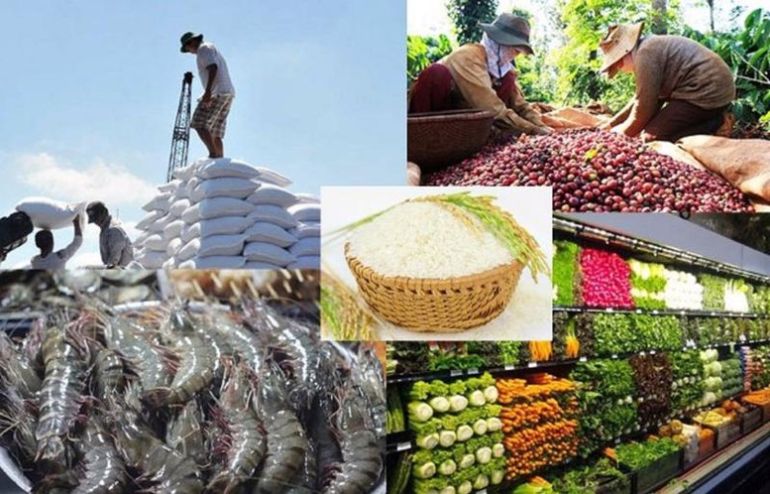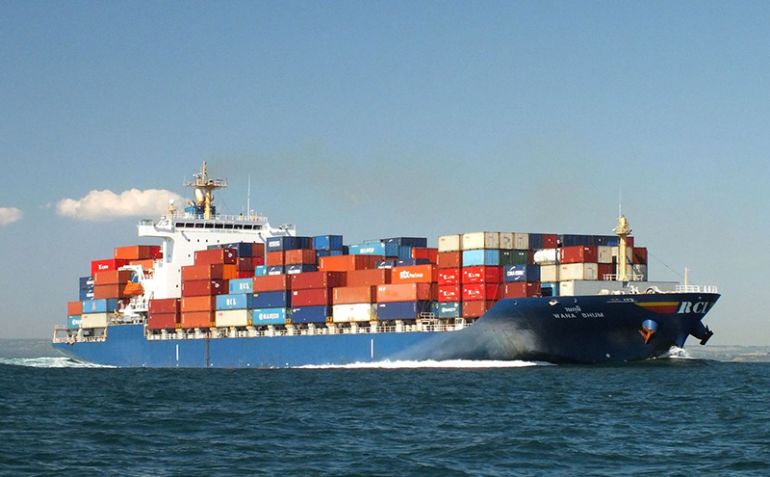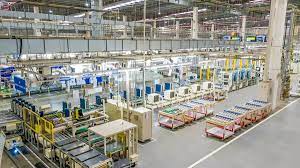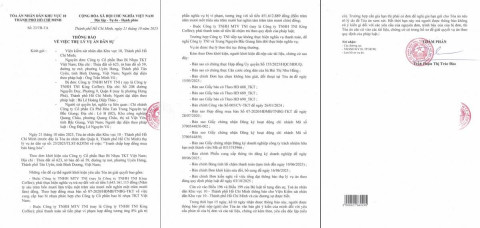Vietnam's agriculture sector and the goal of achieving $54 billion in agricultural exports
- 216
- Business
- 14:48 08/07/2024
DNHN - The Vietnamese agriculture sector has made significant progress in recent years, and currently, the goal is to boost agricultural exports to reach $54 billion.

According to the Ministry of Agriculture and Rural Development, in the first six months of 2024, the trade surplus of the agriculture sector reached approximately $8.28 billion, a 62.4% increase compared to the same period in 2023. At the same time, the GDP growth of the agriculture, forestry, and fisheries sector reached 3.34%, contributing 5.36% to the total added value growth of the economy. These achievements are not only a solid foundation but also a crucial motivation for driving the agriculture sector's breakthrough in the second half of 2024.
With a positive outlook for 2024, Vietnam's agricultural, forestry, and fishery export turnover is projected to reach between $54 and $55 billion. Currently, there are seven products and product groups surpassing the $1 billion mark in export value, including coffee, rubber, rice, fruits and vegetables, cashew nuts, shrimp, wood and wood products.
Among them, rice and cashew nuts have shown growth in both volume and value compared to the same period in 2023. Specifically, rice exports reached 4.68 million tons (up 10.4%), valued at $2.98 billion (up 32%); cashew nuts reached 350,000 tons (up 24.9%), valued at $1.92 billion (up 17.4%). For coffee, despite a 10.5% decrease in volume, the average export price increased by 50.4%, resulting in an export value of $3.22 billion, up 34.6%.
In recent years, Vietnam's agriculture sector has made significant progress and achieved important milestones. Agricultural output has increased significantly, meeting domestic demand and providing a large supply for the export market. This progress is driven by the adoption of advanced technologies, the development of high-quality crop varieties, and the efficient use of fertilizers and pesticides.
Additionally, the productivity and quality of agricultural products have been significantly improved thanks to these innovations. The agricultural infrastructure system has also been upgraded, enhancing the capacity for transportation and preservation of agricultural products. These achievements not only serve as a strong motivation for the sustainable development of Vietnam's agriculture sector but also contribute positively to the national economy.
Vietnam possesses an advantage in the diversity of agricultural products, from staple items like rice, coffee, cashew nuts, and rubber to various fruits and vegetables, seafood, and industrially processed agricultural products. The quality of Vietnamese agricultural products is increasingly recognized by international markets, thanks to compliance with high standards of food safety and environmental sustainability.
Notably, Vietnam has signed numerous free trade agreements with other countries and regions around the world, opening up opportunities for exporting agricultural products to major markets such as Europe, the United States, Japan, South Korea, and China. These efforts not only help boost the agricultural economy but also contribute to improving the livelihoods of rural people and promoting sustainable development for Vietnam's agriculture sector.
To enhance the productivity and quality of agricultural products, we need to continue promoting research and the application of advanced technologies in agriculture. Increasing the use of organic and microbial fertilizers, and implementing clean and safe production processes are essential steps to ensure productivity and product quality.
Building the brand of Vietnamese agricultural products is also a crucial priority. Investing in brand promotion through activities such as exhibitions, trade fairs, and media campaigns will help elevate the value and reputation of Vietnamese agricultural products in the international market.
To achieve this, strengthening cooperation and information sharing is extremely important. Enhancing links with agricultural associations, export enterprises, and relevant agencies to share market information, export regulations, and new business opportunities will help optimize export potential.
Simultaneously, investing in transportation infrastructure and technology is necessary to improve the preservation and processing systems for agricultural products. This ensures that products maintain high quality when reaching international markets.
Finally, training and improving human resource capacity is a decisive factor. Investing in training farmers, agricultural experts, and related personnel, enhancing knowledge in agricultural management, quality standards, and exports will help Vietnam's agriculture sector develop sustainably and compete in the international market.
With the potential and efforts of Vietnam's agriculture sector, the goal of achieving $54 billion in agricultural exports is entirely feasible. This not only brings strong economic development opportunities for Vietnam but also contributes to improving the livelihoods of rural people, creating jobs, and attracting investment into the agriculture sector.
Nghe Nhan
Related news
#export activities

Export businesses face difficulties as sea freight rates rise
Logistics costs have now increased by about 130% compared to the end of 2023. This reality has been pushing domestic export businesses into a state of freezing many export orders.

Ministry helps enterprises effectively deal with trade remedies
The Ministry of Industry and Trade (MoIT) will continue to coordinate with relevant ministries and sectors in supporting businesses to minimise impacts of trade remedies which may have an detrimental effect on Vietnam’s export activities.
Đọc thêm Business
From New Year messages of World Leaders to the “new rules” of the Global economy in 2026
At a pivotal moment of transition, New Year messages from capitals such as Hanoi, Beijing, Washington and Paris reflect distinct priorities and strategic visions.
Connecting Leaders, Shaping the Future: Strategic Leadership Planning Meeting – CorporateConnections Hanoi A
"Your network is your most powerful flowing asset. It generates value, multiplies opportunities, and accelerates your influence across borders."
Innovative ESG enterprise: Trạm Xe Việt startup proposes solutions to build a green mobility ecosystem
As Vietnam commits to achieving Net Zero by 2050 and tightens emissions standards, the transportation sector faces unprecedented pressure to transform.
Deputy Prime Minister Nguyễn Chí Dũng: “The country’s major challenges weigh heavily on my mind — and we must resolve them together.
On the morning of November 26, 2025, Deputy Prime Minister Nguyễn Chí Dũng chaired a high-level working session at the National Innovation Center (NIC) in Hòa Lạc.
Unitsky String Technologies signs cooperation agreements with three Vietnamese partners, opening a new direction for smart mobility and sustainable development
The signing ceremony took place in Minsk, Belarus, on November 28, 2025.
Before the D‑day to abolish flat‑rate tax: Fear of technology and costs leave small traders struggling to adapt
From 1 January 2026 the flat‑rate tax regime will be abolished. Small business households will be required to declare tax based on actual revenue. MISA supports the transition with technology to help micro‑merchants adapt smoothly and transparently.
Vietnamese enterprises at a crossroads: the impact of a potential US–China deal
As the world closely monitors every shift in US-China relations, emerging signals of a strategic agreement between the two global powers are raising hopes for global economic stability.
HDBank: Impressive profit growth, leading in profitability and advancing international integration
Ho Chi Minh City Development Joint Stock Commercial Bank (HDBank, stock code HDB) announced its consolidated profit before tax for the first 9 months of 2025 reached VND 14,803 billion, marking a 17% increase year-on-year (YoY).
TNI King Coffee sued for over VND 5 Billion in unpaid debts
On October 21, 2025, the People’s Court of District 10 in Ho Chi Minh City officially accepted a civil lawsuit concerning a commercial contract dispute between TKT Vietnam Plastic Packaging Joint Stock Company and TNI King Coffee Co., Ltd.
VINASME and Jeonnam Technopark Sign MOU on technology cooperation, human resource training, and trade promotion
On October 15, 2025, in Hanoi, VINASME and Jeonnam Technopark (Korea) signed an MOU to promote trade, advance technology transfer, and develop human resources between enterprises of both nations.











